
AS the saying goes, it is not always what you know, but who you know. In 2010 Dr Matt Trinca, director of the National Museum of Australia (NMA) worked with Fr Nicola Mapelli, director of the Vatican “Anima Mundi” Museum, when he re-opened the ethnological collections with “Rituals of Life”, an exhibition dedicated to the spirituality and culture of indigenous Australians.

Islamic objects from the Vatican Museum, mostly given as gifts to Pope Pius XI in 1925, were exhibited in the Museum of Islamic Civilization, Sharjah, in 2014 during the celebrations of the Islamic Educational Scientific and Cultural Organisation. During a research trip to Australia, Fr Mapelli and curator Katherine Aigner met Dr Trinca and proposed a similar Islamic exhibition for Australia.

The result of these professional relationships is a unique collaboration among three museums from three continents showing parts of the world of Islam from Africa and Asia and Australia through their own collections.
The title of the exhibition – which was also used in 2014 – was inspired by a verse within the Holy Qur’an, and invites the audience to reach across religions and cultures in a spirit of positive curiosity, creativity, friendship, tolerance and peace.
Through the objects in the exhibition the audience gets a glimpse of the diverse ways of Muslim life all over the world. The exhibition is intended to increase intercultural dialogue and promote tolerance and peace.
As Dr Trinca says: “objects can serve as ambassadors for the people and cultures for whom they are an expression”.
Through musical instruments, garments, jewellery, horse trappings, hangings and more, I can see that the artists who made them and those who used them are people – just like me. They live, work and love – just as all people do. I can admire their skills, their appreciation of fine handcrafts, and their penchant for beautiful objects. Traditional Muslim societies from Africa to China can be seen in the show, and I see the “ordinary” lives of the people from these countries.
Someone commented that this was a brave exhibition for the Museum to be showing. From my point of view, this exhibition could only happen at the NMA, and at this time.

People of Islamic faith made an important contribution to the history of Australia from the18th to the early 20th centuries. In the north coasts of Australia, Makasar traders from Sulawesi, when collecting trepang, sea cucumbers, developed mutually beneficial trading and working relationships with the local Aboriginal people. Paintings and carvings from mid-20th century represent the processes of boiling down the trepang collected by the Makasar, and a large “Kawa” (cauldron) in cast iron – a valuable item from the site – is on display.
The second group of Muslims to arrive in Australia were the cameleers, known as “Afghans” or “Ghans”. They came from parts of India and present-day Pakistan. They, and the camels they worked with, were well-equipped to assist in the exploration and development of inland Australia. Their stories are told through the life of Bejah Dervish, a legendary figure. His descendants still live in parts of Australia and a very interesting short documentary focuses on him, the camels and his family.
Underpinning this impressive show is a fundamental desire for mutual understanding and dialogue between cultures and faiths.
This is an intelligent, interesting and illuminating exhibition.
Who can be trusted?
In a world of spin and confusion, there’s never been a more important time to support independent journalism in Canberra.
If you trust our work online and want to enforce the power of independent voices, I invite you to make a small contribution.
Every dollar of support is invested back into our journalism to help keep citynews.com.au strong and free.
Thank you,
Ian Meikle, editor




Leave a Reply